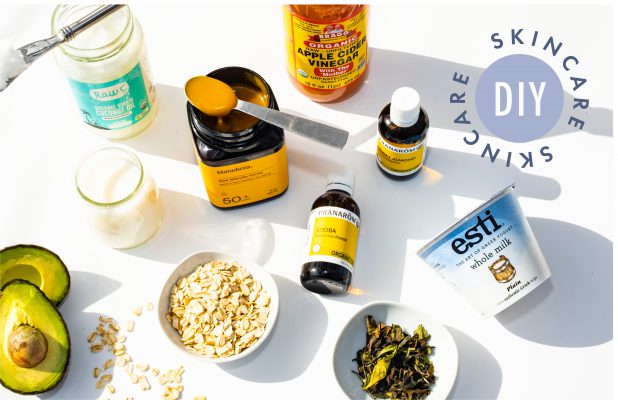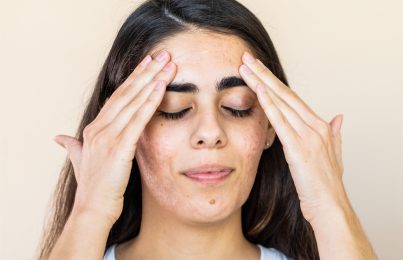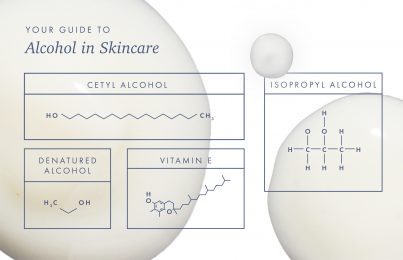Updated 03/23/22. DIY skincare continues to be popular. It’s fueled, in part, by the craft movement, and it involves putting items that are usually found in the kitchen onto the skin in an effort to achieve a certain result. As a skincare expert, I’m often asked by magazines and blogs to contribute DIY skincare recipes and whenever I do, they are always well received by readers. But do these DIY skincare recipes really work to achieve clearer, healthier-looking skin?
At first glance, it might seem that way. After all, the thought of using something in its natural, unadulterated form seems to be the healthiest and most efficient way to go, right? Not so fast. Let me provide some insight, first. When you eat something, your saliva starts to break down the food. It then goes through the digestive tract and nutrients from the food will be distributed throughout the body wherever they are needed. The skin doesn’t have a process like the digestive system does; therefore, it isn’t really possible to put food on the face and expect the nutrients to easily penetrate into the skin.
That’s not to say that there aren’t any beneficial DIY skincare recipes out there. Personally, I use a DIY hand and body scrub to keep my skin smooth and soft. It’s definitely effective!
Keep reading to learn more about my thoughts on the DIY skincare movement, including which ingredients I think are okay to use on your skin and which ones I recommend avoiding!
The Safety and Efficacy of Common DIY Skincare Ingredients
1. Plants (White Tea Leaves, Rosemary Leaves, and Eucalyptus Leaves)
Some people crush leaves and rub them directly on their skin. Or, they soak leaves in hot water to create a DIY toning mist. While some plants and leaves have potent soothing, energizing, and antioxidant properties, you mainly get the fiber and caloric content properties when they’re used this way. Unfortunately, these don’t offer any value to the skin.
It’s important to note that even though plants have enzymes, vitamins, and amino acids that have all their own benefits, only antioxidants can be absorbed through the skin. It’s only when science is involved and plants are extracted (known as a “plant extract”) that they’re able to penetrate into the deeper layers of the skin and participate in various cellular activities. When delivered this way, plants supply the skin with a variety of elements, helping to remedy possible deficiencies and take an active part in metabolism.
It’s important to note that skincare companies that formulate their own products demand “standardized” plant extracts from their suppliers. This allows us to know the exact composition of the extract and every constituent in it; therefore we can measure the extract’s performance and ensure its consistency.
It’s also important to note that many active ingredients used in products come from the parts of plants that you don’t eat, like the stems, seeds, and roots.
2. Yogurt or Milk
You may have heard yogurt and milk contain natural lactic acids which can be used as an exfoliant to smooth skin in its pure form, but this isn’t quite true. These foods are not effective because they are not in an absorbable form. Also, the pH of milk is only 6.5 and yogurt is generally around 5.0. At these levels, they are not low enough to truly have exfoliating properties, such as glycolic, lactic, salicylic, or malic acid-based serums (which have pHs around 3.0 or 4.0). Simply put, in order for an acid to be truly effective in dissolving dry skin cells, the pH needs to be much lower than what edible items contain.
3. Vitamin C Tablets
I’ve heard of people crushing up a vitamin C tablet and applying it to their skin (sometimes mixed with a natural oil) to create a DIY antioxidant serum. Here’s the thing, though. Vitamin C has a difficult time penetrating the skin. Even the best cosmetic forms of vitamin C struggle with this issue. That’s why the delivery system is crucial.
Plus, improper forms of vitamin C can irritate the skin, doing more harm than good. In fact, since this ingredient is highly unstable and oxidizes quickly, it can actually promote blackhead formation by speeding up sebum oxidation when used in this way. This also applies when using pure lemon juice on the skin (but more on that in a second).
I’ve also heard of people taking the peel of an orange and baking it in the oven before hand-grinding with a mortar and pestle to make a fine powder. This is then mixed with various ingredients in an attempt to give the skin antioxidants from the vitamin C found in the orange peel. For the record, this one is complete nonsense mainly because the heat from the oven would negate the vitamin C content completely.
Bottom line, if you have sensitive skin, and you’re looking for an effective way to get scientifically-proven, stable antioxidants into the skin, I highly recommend using the Vitamin C&E Treatment daily under sunscreen.
4. Sugar, Salt, Baking Soda, and Oats
These particles are used in DIY skincare recipes as physical exfoliants. They roll over the skin and lift off dry surface cells. These can be very effective. However, when using sugar or salt, I recommend only using it on the body, since they can be too rough for the face (especially if you have sensitive skin!).
5. Zinc Oxide and Titanium Dioxide
I’ve heard of people mixing pure zinc oxide or titanium dioxide with coconut oil to make their own sunscreen. While zinc and titanium are excellent sunscreen ingredients, you can’t get the same level of protection when you’re making your own. After all, sunscreens must be FDA-approved and go through rigorous testing to ensure their effectiveness.
UV light from the sun is the number one cause of premature skin aging. This makes sunscreen the best preventative skincare product on the planet. You don’t want to jeopardize this important step in your routine by using a DIY recipe (trust me on this).
6. Aspirin
This DIY skincare ingredient is sometimes said to have similar properties to beta-hydroxy acids (BHAs), like salicylic acid. The truth is that aspirin is the active acetylsalicylic acid, so it’s not technically the same thing as salicylic acid. In fact, it doesn’t become salicylic acid until it is metabolized after ingestion. Comparing the results of a well-formulated BHA serum to that of aspirin is unfounded. It’s hard enough to formulate with salicylic acid, as it’s a challenge to keep it stable and its pH low. So, trust me, clearing breakouts isn’t as simple as rubbing aspirin on your face. Well-formulated topical products are your best bet.
7. Natural Oils, Avocado, Mayonnaise, and Honey
Natural oils, like sweet almond oil and jojoba oil, are common DIY ingredients. So are avocado, mayonnaise, and honey. All of them have moisturizing or humectant properties and are often used in DIY face mask recipes. I actually don’t have an issue with any of these being used topically on the skin because moisture is always needed and these common goods can provide benefits.
8. Lemon, Lime, or Other Citrus Fruits
You absolutely never, ever want to apply pure lemon juice to the skin, as it’s phototoxic and could severe dryness and irritation. Plus, pure lemon juice doesn’t have the advanced delivery system and stability of a well-formulated skincare product, so it wouldn’t give a preventative aging benefit anyways. (I have personal experience with this. I developed something called phytophotodermatitis on my leg after I accidentally spilled some lemon water on it while out in the sun!)
My Thoughts on DIY Skincare as a Whole
There have been incredible advancements in skincare technology. Tremendous scientific brainpower is dedicated to research and development. We have learned so much about how the skin works in the past 25 years and what we can do to slow down (and sometimes reverse) the visible signs of aging, as well as clearing breakouts. Skincare products and treatments are becoming increasingly sophisticated and are able to target the critical functions of skin health. For example, we can now safely speed up the skin renewal process without unwanted dryness and irritation, with products that contain retinol, like the Advanced Resurfacing Serum. There are new products coming out that may be able to mimic DNA functions of healthy skin to address damage on an individual cell level. Many products successfully harness the healing power of antioxidants, which play a very important role in preventing free radical damage.
In other words, if you’re wanting true change in your skin, there is no better place to find it than with science. As a colleague recently said to me, “If you have an infection, you don’t have to eat moldy bread to get an antibiotic. You can take a pill orally.” (Not that moldy bread would be effective for treating an infection anyway.) We all can benefit from science.
That’s why, in my skincare line, I use the benefits of both nature and science. Nature offers a slow and steady course that works gently with the skin, while science offers the more advanced, sometimes stronger ingredients, that are required as we age. (Read more about my thoughts on natural skincare and the safety of ingredients.)
I also believe that a skincare company has to be responsible for what they are selling—they must sell truths. On the organic side, I see all sorts of lies and scare tactics to make you believe that certain ingredients are toxic. On the science side, I see companies cutting corners and creating cheap ingredients for the sake of profits.
The Bottom Line
In summary, most DIY skincare ingredients are simply not in an absorbable form. Physiologically, they are nowhere near as effective at absorbing into the skin and they are not in a stable form that can hold up the way well-formulated products can.
With that being said, it’s okay to be a naturalist. If you love your DIY skincare recipes and they work for you, then go for it. I’m certainly not here to force anyone to care for their skin in a certain way; I’m simply sharing what I know to be true. So, take this as my personal food for thought! After all, caring for our skin, in any form, brings confidence. It’s a ritual that makes us feel cared for, and we all win from that.
Next, find out if the food you eat really affects your skin!
Celebrity Esthetician & Skincare Expert
As an esthetician trained in cosmetic chemistry, Renée Rouleau has spent 30 years researching skin, educating her audience, and building an award-winning line of products. Her hands-on experience as an esthetician and trusted skin care expert has created a real-world solution — products that are formulated for nine different types of skin so your face will get exactly what it needs to look and feel its best. Trusted by celebrities, editors, bloggers, and skincare obsessives around the globe, her vast real-world knowledge and constant research are why Marie Claire calls her “the most passionate skin practitioner we know.”




Comments:
Renee, I love everything you said about staying true to your beliefs and not selling out or expanding. I will admit I wondered why you hadn’t expanded more when you have such a great company that stands for all the right things. Now I know, and I’m just so glad to have found your line and to have the access to your wealth of information. Thank you so much for being a trusted source in this crazy industry. I’ve struggled with my skin since I was 12, and I’m still struggling at 26; but I feel like your posts are finally providing me with the knowledge I’ve been trying to seek all of these years. Thank you so much for being honest and for staying true to yourself. I hope one day I’ll be able to have clear, glowing skin, and that I’ll be able to credit it all to you! 🙂
Posted By: Rachel Dara |
Hi Rachel! Thank you for your sweet comments and I’m so glad that you are educating yourself with my posts on how to best care for your skin. Products will do their part but often times it’s the little lifestyle tweaks that can make even a bigger difference!
Posted By: Renée Rouleau |